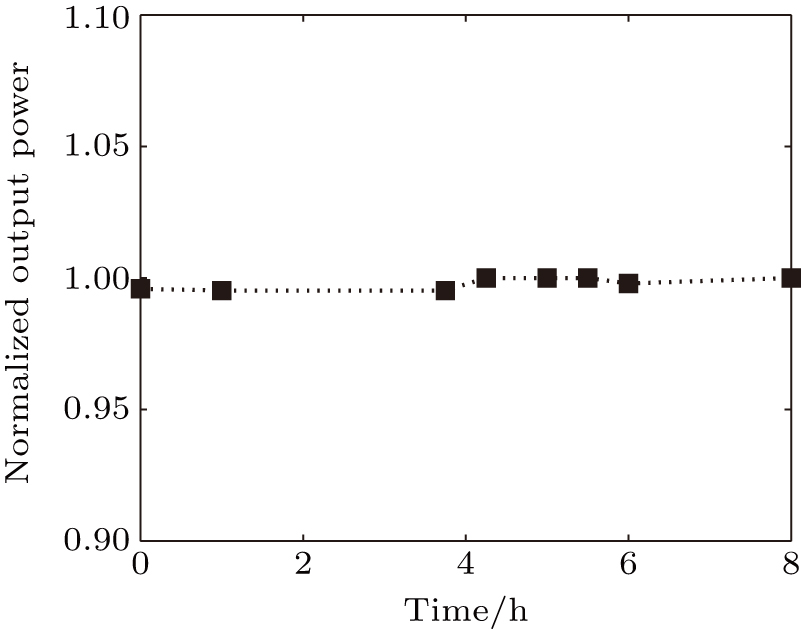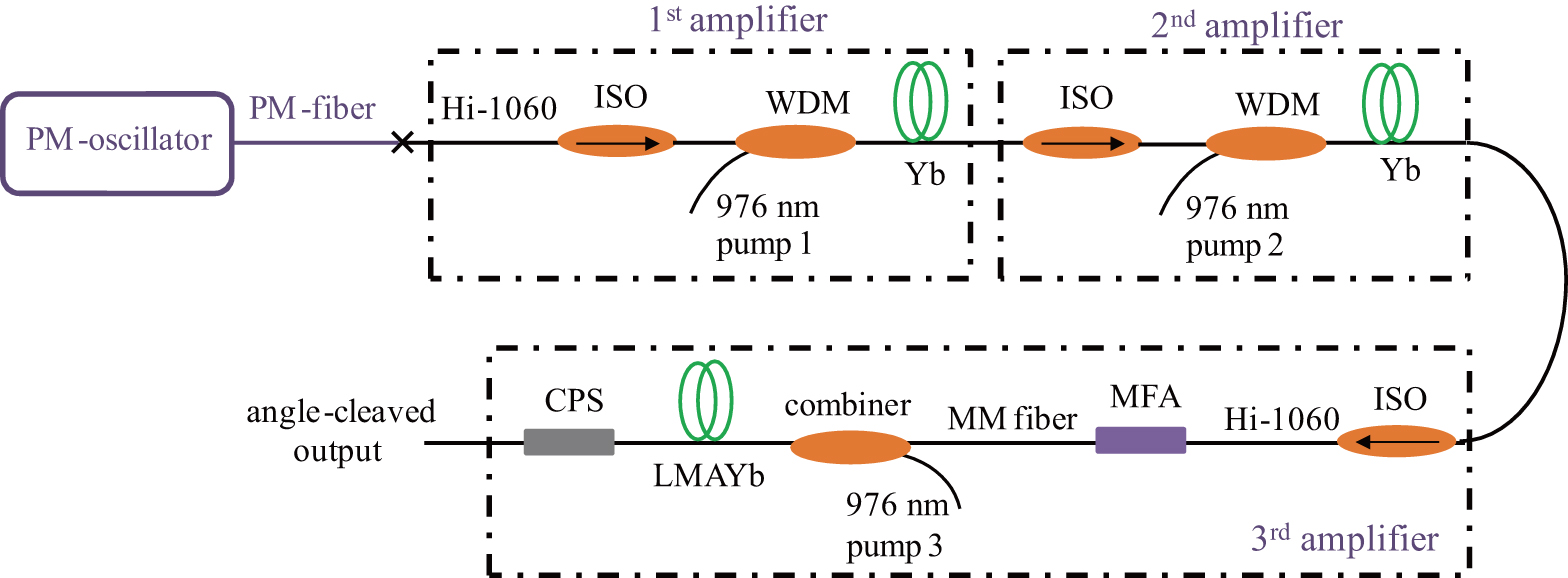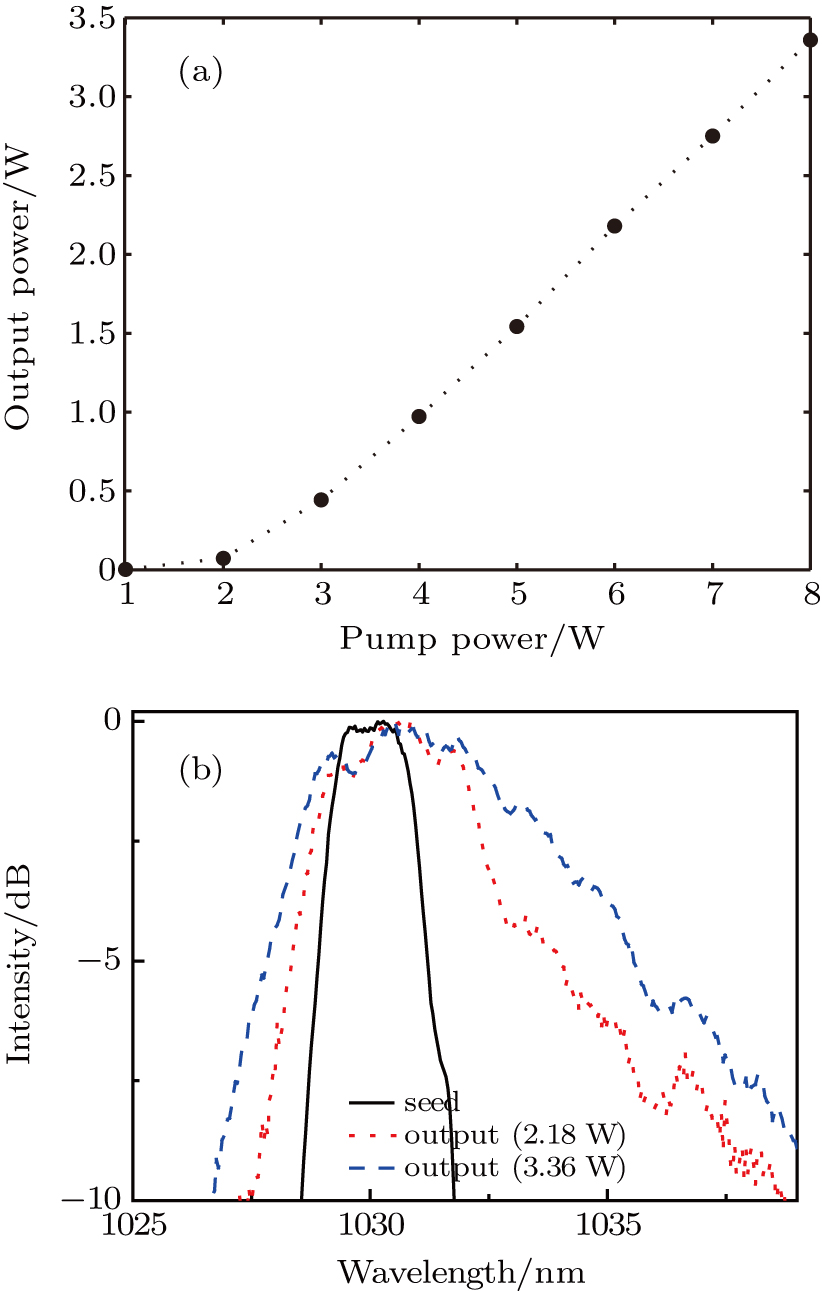† Corresponding author. E-mail:
A low-repetition-rate, all-polarization-maintaining (PM)-fiber sub-nanosecond oscillator is presented, which is simple and low-cost, composed of standard components. The ring cavity is elongated by 114-m-long standard PM fiber, and passively mode-locked by a fiber pigtailed semiconductor saturable absorber. Linearly polarized pulses with 1.66 MHz repetition rate and 22 dB polarization extinction ratio are generated at a wavelength of 1030 nm, which is determined by an intracavity filter. In addition, to demonstrate that the oscillator is a good seed for high energy pulse generation, an all-fiber master oscillator power amplifier is built and amplified pulses with energy about 
Pulsed laser sources have great potential applications in many fields, e.g., optical measurement, optical fiber communication, medicine, and micromachining. Passively mode-locked fiber lasers, with the advantages of compact, stable, and low-cost, are alternative pulse sources to their solid-state counterparts.[1] However, the single-pulse energy of a soliton fiber laser is limited by the nonlinear effects of the fiber.[2] Recently, all-normal-dispersion (ANDi) mode-locked fiber lasers attracted lots of attention, which are promising compact pulse sources for their high-energy output and simplified laser cavity.[3–5] The pulse in the ANDi oscillator is a kind of dissipative soliton, which is formed by a balance of gain, loss, dispersion, and nonlinearity.[6,7] The architecture of ANDi lasers is especially convenient for the Yb-doped fiber laser working at the 
By extending the fiber length of the cavity, ANDi fiber lasers can still mode-lock and output low-repetition-rate pulses.[10] A long-cavity mode-locked fiber laser, as a seed of the master oscillator power amplifier (MOPA), is promising for generating high-energy pulses. Since the pulse energy can be calculated by dividing the average power by the repetition rate, decreasing the repetition rate will increase the pulse energy. Usually a pulse picker is used in the MOPA to decrease the repetition rate of the seed and increase the amplified pulse energy. Using the low-repetition-rate laser as the seed can refrain MOPA from the pulse picker.[10] There are lots of investigations on low-repetition-rate Yb-doped mode-locked fiber lasers, e.g., lasers mode-locked by nonlinear polarization rotation (NPR) with free-space components,[11] by NPR with all-fiber components,[12] by nanotubes absorber,[13] or by semiconductor saturable absorber mirror (SESAM).[14]
More recently, in order to obtain stable output pulses, low-repetition-rate Yb-doped fiber lasers composed of all-polarization-maintaining (PM) fiber were proposed and demonstrated. In the PM fiber, the linear polarization state of light could be forcedly maintained along the propagation, preventing the change of the polarization state due to environmental perturbation.[15] An all-PM fiber laser with a repetition rate of 1.7 MHz was obtained, which was mode-locked by a nonlinear amplified loop mirror (NALM).[16] In a cavity with similar structure, 2.47 MHz all-PM fiber laser with higher pulse energy was achieved.[17] By combining the angle-spliced PM fibers and a Faraday mirror, mode-locked all PM-fiber lasers were achieved by use of NPR, with repetition of 1 MHz[18] or 948 kHz.[19] A nanotube absorber was used to mode-lock a 641-kHz all-PM-fiber ANDi laser, where a segment of 300-m-long PM highly-nonlinear fiber was used in the cavity and the spectral filtering was provided by the limited gain bandwidth.[20] SESAM was used to mode-lock a linear cavity with a repetition rate of 0.7 MHz, where a narrow-band (
In this paper, a simple and low-cost low-repetition-rate, all-PM Yb-doped fiber laser is reported, which consists of standard components. The ring cavity, elongated by 114-m-long standard PM ANDi fiber, is passively mode-locked by a fiber pigtailed semiconductor saturable absorber (SSA) in transmission mode. Linearly polarized sub-nanosecond pulses with 1.66 MHz repetition rate and 22 dB polarization extinction ratio (PER) are generated at a wavelength of 1030 nm, which is determined by a band-pass filter. Based on the oscillator, a MOPA is built to demonstrate the amplification of the oscillator, and high energy pulses (about 
Figure 
In order to obtain a mode-locked laser with sufficient low-repetition-rate, intracavity standard PM fibers with different lengths are tried to extend the cavity as long as possible. Once the cavity is built, only one parameter, i.e., the pump power, can be tuned to reach the mode-locking state. For a cavity with appropriate length, self-starting mode-locking can be achieved in a range of pump powers. The pump power ranges corresponding to mode-locked lasers with different repetition rates are illustrated in Fig.
The output of the oscillator (with repetition rate of 1.66 MHz) is measured and shown in Fig.
The stability of the output average power is measured by keeping the laser running for 8 hours. The measured output powers at different times are shown in Fig.
In order to confirm the polarization of the output, a setup for PER measurement is built, as shown in Fig. 

In order to demonstrate the performance of the oscillator serving as a seed for MOPA, an all-fiber three-stage Yb-doped fiber amplifier is built, as shown in Fig. 


Firstly, the architecture and components of the proposed laser cavity are discussed. Since the pulse duration is sub-nanosecond, which is much longer than the relaxation time of general SA, there is no specific requirement for the SA’s relaxation time. For the WDM, it has a limited bandwidth for the pulse, however, the bandwidth is much broader than that of the following PM-filter, and thus the filtering effect of the WDM can be neglected. In order to further validate it, simulations of the proposed oscillator are conducted, with a numerical model similar to that in Ref. [8] and simulation parameters the same as those in our experiments. By neglecting the bandwidth of the WDM, simulations show that the laser can be mode-locked, indicating that the filtering effect of the WDM could be neglected. Moreover, we also numerically and experimentally investigate the pulse dynamics by changing the placement of different components in the cavity. It is found that, it is not necessary to place these components in the cavity strictly in the order shown in Fig.
Then the process of MOPA is discussed. As shown in Fig. 
An all-PM Yb-doped fiber laser, with low-repetition-rate (1.66 MHz), sub-nanosecond duration, and linearly-polarized (PER of 22 dB) output pulses, is reported. The length of the ring cavity is extended by a segment of standard PM fiber, and a PM-fiber pigtailed SSA and a PM band-pass filter are used to initiate the pulse output. Moreover, based on the oscillator, an all-fiber MOPA is demonstrated to obtain high-energy (
The author would like to thank Pan Wang for his help with the numerical simulations, and Xinyu Huang and Yan Li for their help with measuring the experiment data, during the revision of this article.
| [1] | |
| [2] | |
| [3] | |
| [4] | |
| [5] | |
| [6] | |
| [7] | |
| [8] | |
| [9] | |
| [10] | |
| [11] | |
| [12] | |
| [13] | |
| [14] | |
| [15] | |
| [16] | |
| [17] | |
| [18] | |
| [19] | |
| [20] | |
| [21] | |
| [22] | |
| [23] | |
| [24] | |
| [25] |








